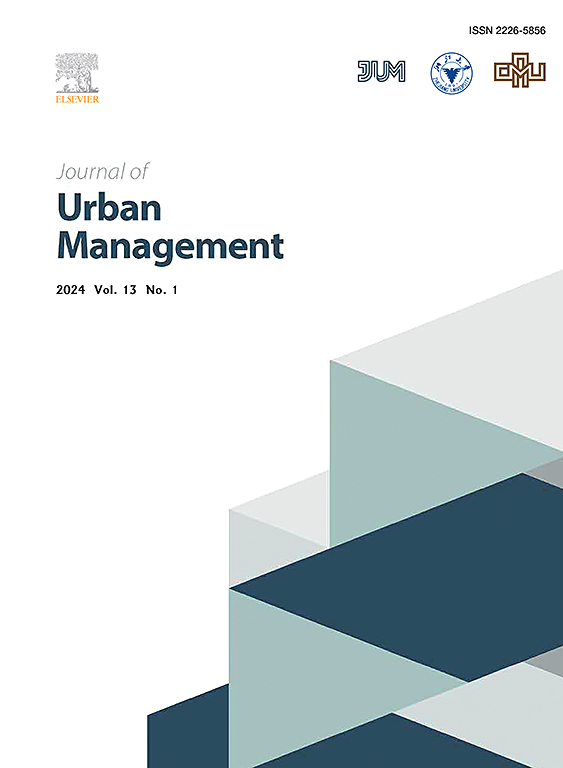揭示大开罗空间结构的转变:卫星图像和地理空间度量的启示
IF 5
2区 社会学
Q1 URBAN STUDIES
引用次数: 0
摘要
大开罗(GC)是全球第七大都市。近几十年来,大开罗见证了大规模的城市扩张,但这一扩张尚未得到实证测量或特征描述。本研究试图利用遥感和地理空间指标探索 1973 年至 2021 年期间大麦加的城市增长模式和城市形态变化。研究使用了 1973 年、1984 年、1992 年、2003 年、2013 年和 2021 年的六幅 Landsat 图像来探索 GC 的城市增长情况。利用城市土地密度函数(ULDF)、景观扩张指数(LEI)和分形维度指数(FDI)来分析城市扩张的各个方面。此外,我们还计算了土地消耗率(LCR)与人口增长率(PGR)之比,以评估城市扩张与人口变化之间的相关性。我们的研究结果表明,在过去的半个世纪中,城市面积大幅增加了 20.3 万公顷。ULDF 突出显示了 GC 从密集型城市景观向分散型城市景观的转变,特别是随着新行政首都在附近的建立。在整个研究期间,边缘扩张成为城市发展的主要类型。外国直接投资从 1973 年的 1.44 持续增长到 2021 年的 1.75,标志着城市景观的碎片化。此外,人均土地覆盖率从 1984 年的 0.023 公顷逐步上升到 2021 年的 0.050 公顷,这表明低密度城区在稳步扩张。值得注意的是,LCR 与 PGR 的比率从 1984 年的 0.878 上升到 2021 年的 2.428,表明城市扩张超过了人口增长。这些结果将有助于进一步了解广州城市扩张的特征,并为决策者重新考虑广州现行的横向扩张政策提供科学依据。本文章由计算机程序翻译,如有差异,请以英文原文为准。
Revealing the transformation of spatial structure of greater Cairo: Insights from satellite imagery and geospatial metrics
Greater Cairo (GC) is the seventh-largest metropolitan city globally. In recent decades, GC has witnessed massive urban expansion, which has yet to be empirically measured or characterized. This research seeks to explore the patterns of urban growth and changes in urban form in GC from 1973 to 2021 using remote sensing and geospatial metrics. Six Landsat images in 1973, 1984, 1992, 2003, 2013, and 2021 were used to explore urban growth in GC. Urban Land Density Function (ULDF), Landscape Expansion Index (LEI), and Fractal Dimension Index (FDI), were utilized to analyze various aspects of urban expansion. Additionally, the ratio of Land Consumption Rate (LCR) to Population Growth Rate (PGR) was calculated to assess the correlation between urban expansion and population changes. Our results reveal a substantial addition of 203 thousand hectares of urban areas over the last half-century. The ULDF highlights GC’s transformation from a condensed to a scattered urban landscape, particularly with the establishment of the New Administrative Capital in the vicinity. Edge expansion emerged as the principal type of urban growth throughout the research duration. The consistent increase in FDI from 1.44 in 1973 to 1.75 in 2021 signifies the fragmentation of the urban landscape. Moreover, the progressive rise in LCR from 0.023 in 1984 to 0.050 ha per person in 2021 suggests a steady expansion of low-density urban areas. Notably, the LCR-to-PGR ratio escalated from 0.878 in 1984 to 2.428 in 2021, indicating that urban expansion surpassed population growth. These results will help further understand the characteristics of GC’s urban expansion and may offer a scientific foundation for policymakers to reconsider the current horizontal expansion policy in GC.
求助全文
通过发布文献求助,成功后即可免费获取论文全文。
去求助
来源期刊

Journal of Urban Management
URBAN STUDIES-
CiteScore
9.50
自引率
4.90%
发文量
45
审稿时长
65 days
期刊介绍:
Journal of Urban Management (JUM) is the Official Journal of Zhejiang University and the Chinese Association of Urban Management, an international, peer-reviewed open access journal covering planning, administering, regulating, and governing urban complexity.
JUM has its two-fold aims set to integrate the studies across fields in urban planning and management, as well as to provide a more holistic perspective on problem solving.
1) Explore innovative management skills for taming thorny problems that arise with global urbanization
2) Provide a platform to deal with urban affairs whose solutions must be looked at from an interdisciplinary perspective.
 求助内容:
求助内容: 应助结果提醒方式:
应助结果提醒方式:


